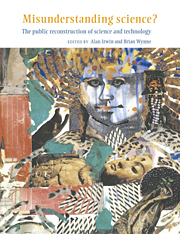Book contents
- Frontmatter
- Contents
- Acknowledgements
- Introduction
- 1 Misunderstood misunderstandings: social identities and public uptake of science
- 2 Science and Hell's kitchen: the local understanding of hazard issues
- 3 Disembodied knowledge? Making sense of medical science
- 4 Now you see it, now you don't: mediating science and managing uncertainty in reproductive medicine
- 5 Ignoring science: discourses of ignorance in the public understanding of science
- 6 Insiders and outsiders: identifying experts on home ground
- 7 Authorising science: public understanding of science in museums
- 8 Nature's advocates: putting science to work in environmental organisations
- 9 Proteins, plants, and currents: rediscovering science in Britain
- Conclusions
- Notes on contributors
- Select bibliography
- Index
9 - Proteins, plants, and currents: rediscovering science in Britain
Published online by Cambridge University Press: 16 October 2009
- Frontmatter
- Contents
- Acknowledgements
- Introduction
- 1 Misunderstood misunderstandings: social identities and public uptake of science
- 2 Science and Hell's kitchen: the local understanding of hazard issues
- 3 Disembodied knowledge? Making sense of medical science
- 4 Now you see it, now you don't: mediating science and managing uncertainty in reproductive medicine
- 5 Ignoring science: discourses of ignorance in the public understanding of science
- 6 Insiders and outsiders: identifying experts on home ground
- 7 Authorising science: public understanding of science in museums
- 8 Nature's advocates: putting science to work in environmental organisations
- 9 Proteins, plants, and currents: rediscovering science in Britain
- Conclusions
- Notes on contributors
- Select bibliography
- Index
Summary
Introduction
As discussed in previous chapters, one important dimension of the contemporary public understanding of science is the heterogeneity of scientific knowledges and understandings. Whilst conventional perspectives portray science as a unitary and coherent body of knowledge and expertise, the accounts in this book have typically stressed the diverse character of science as it is encountered by various publics. In looking to the future development of science–public relations it is important also that we consider the changes which are currently affecting modern science – not least because these will help form the new context for these relations. In a book devoted to the linkages between science and the public we therefore need to examine the various and shifting understandings of science within the scientific community.
Accordingly, this chapter seeks to identify how science is contextualised by academic scientists, administrators, industrialists, and members of some environmental organisations, and distinguishes between the various, and largely disparate, ‘understandings’ of strategic science held and enacted in the civil sector of British science. It is based on an investigation conducted in the context of policy changes at the political level which have borne most directly in recent years on the development of science and technology policy in Britain. There are several policy changes which deserve special consideration with regard to British civil science in the 1990s. First, the move towards the prioritisation of key areas of scientific research using special programmes for the focusing of government funding. Second, the fact that these have evolved within an increasingly stringent economic framework. Third, the narrowing of the institutional base for this work through a process of rewarding ‘excellence’ and the concentration of resources in key institutions.
- Type
- Chapter
- Information
- Misunderstanding Science?The Public Reconstruction of Science and Technology, pp. 191 - 212Publisher: Cambridge University PressPrint publication year: 1996
- 5
- Cited by

